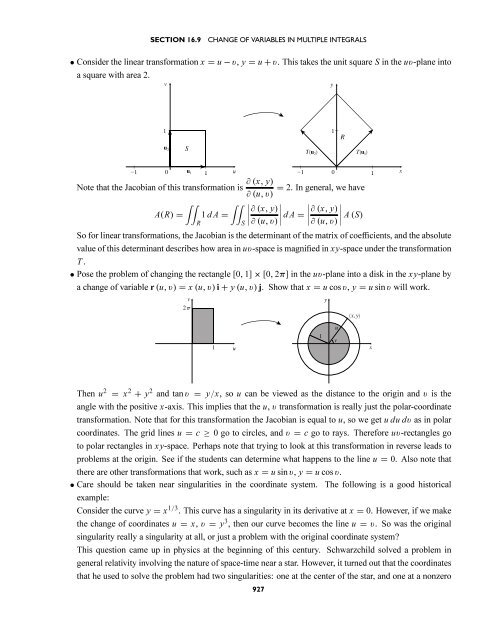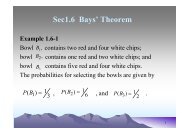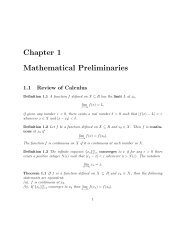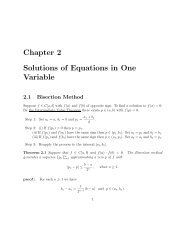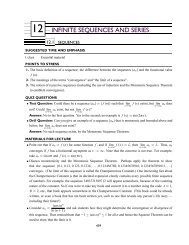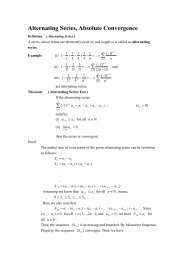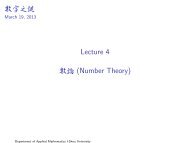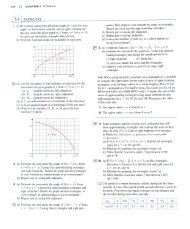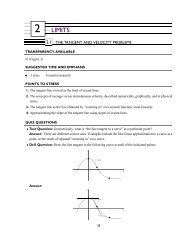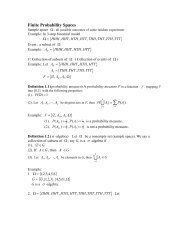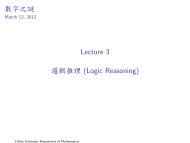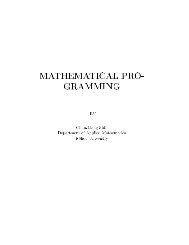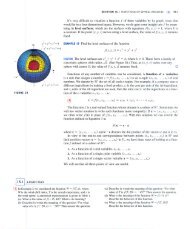16 MULTIPLE INTEGRALS
16 MULTIPLE INTEGRALS
16 MULTIPLE INTEGRALS
Create successful ePaper yourself
Turn your PDF publications into a flip-book with our unique Google optimized e-Paper software.
SECTION <strong>16</strong>.9<br />
CHANGE OF VARIABLES IN <strong>MULTIPLE</strong> <strong>INTEGRALS</strong><br />
• Consider the linear transformation x = u − v, y = u + v. This takes the unit square S in the uv-plane into<br />
a square with area 2.<br />
∂ (x, y)<br />
Note that the Jacobian of this transformation is = 2. In general, we have<br />
∂ (u,v)<br />
∫∫ ∫∫<br />
∣ A(R) = 1 dA=<br />
∂ (x, y)<br />
∣∣∣ ∣<br />
R<br />
S ∂ (u,v) ∣ dA= ∂ (x, y)<br />
∂ (u,v) ∣ A (S)<br />
So for linear transformations, the Jacobian is the determinant of the matrix of coefficients, and the absolute<br />
value of this determinant describes how area in uv-space is magnified in xy-space under the transformation<br />
T .<br />
• Pose the problem of changing the rectangle [0, 1] × [0, 2π] in the uv-plane into a disk in the xy-plane by<br />
a change of variable r (u,v) = x (u,v) i + y (u,v) j. Show that x = u cos v, y = u sin v will work.<br />
Then u 2 = x 2 + y 2 and tan v = y/x, sou can be viewed as the distance to the origin and v is the<br />
angle with the positive x-axis. This implies that the u, v transformation is really just the polar-coordinate<br />
transformation. Note that for this transformation the Jacobian is equal to u, sowegetududv as in polar<br />
coordinates. The grid lines u = c ≥ 0gotocircles,andv = c go to rays. Therefore uv-rectangles go<br />
to polar rectangles in xy-space. Perhaps note that trying to look at this transformation in reverse leads to<br />
problems at the origin. See if the students can determine what happens to the line u = 0. Also note that<br />
there are other transformations that work, such as x = u sin v, y = u cos v.<br />
• Care should be taken near singularities in the coordinate system. The following is a good historical<br />
example:<br />
Consider the curve y = x 1/3 . This curve has a singularity in its derivative at x = 0. However, if we make<br />
the change of coordinates u = x, v = y 3 , then our curve becomes the line u = v. So was the original<br />
singularity really a singularity at all, or just a problem with the original coordinate system?<br />
This question came up in physics at the beginning of this century. Schwarzchild solved a problem in<br />
general relativity involving the nature of space-time near a star. However, it turned out that the coordinates<br />
that he used to solve the problem had two singularities: one at the center of the star, and one at a nonzero<br />
927


